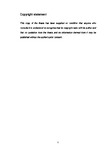AN ASSESSMENT OF CURRENT METHODOLOGIES FOR MITIGATING THE POTENTIAL EFFECTS OF ANTHROPOGENIC UNDERWATER SOUND ON MARINE LIFE, AND RECOMMENDATIONS FOR BEST PRACTICE
| dc.contributor.supervisor | Abbott, Victor | |
| dc.contributor.author | Compton, Ross Craig | |
| dc.contributor.other | School of Biological and Marine Sciences | en_US |
| dc.date.accessioned | 2014-01-02T16:11:27Z | |
| dc.date.available | 2014-01-02T16:11:27Z | |
| dc.date.issued | 2013 | |
| dc.identifier | 287303 | en_US |
| dc.identifier.uri | http://hdl.handle.net/10026.1/2857 | |
| dc.description.abstract |
Underwater sound from anthropogenic sources such as seismic surveys, marine renewable device installations and naval exercises has the potential to disturb and cause injury to a variety of marine species. There is particular concern for the potential effects upon marine mammals, which utilise sound to communicate, hunt and navigate. Observed effects include behavioural changes and reduced sighting rates, with unknown consequences for individuals or populations over time. Potential effects on marine mammals include sound induced damage to auditory systems, altered diving behaviour potentially resulting in decompression sickness, stranding and death. The aim of the thesis was to develop a framework of best practice measures relating to mitigating the potential effects of underwater sound on marine mammals during offshore exploration and development operations. In order to mitigate the potential effects of underwater sound, regulatory guidelines have been developed and implemented around the world, principally for seismic surveys. These guidelines limit the activation of seismic sources when in proximity to marine species, and involve the use of specially trained personnel on survey vessels known as Marine Mammal Observers (MMOs). A critical review of the guidelines identified variation in the level of precaution applied to measures, such as the distance at which species can be sighted before reducing sound output from the operation. MMOs collect sighting information for all encounters with marine species, resulting in large volumes of data detailing species occurrence and behaviour. A sample dataset was found to be subject to variation in quality due to the different academic backgrounds and training levels of personnel. The data highlighted significant differences in relation to sighting distance while the sound source is active or inactive, though lacked detail with regard to behaviours, likely due to the lack of ethological expertise among the observers. A questionnaire was conducted to determine any differences of opinion regarding current mitigation practice and the underlying issue between stakeholder groups. There was no difference of opinion between stakeholders regarding the importance of underwater sound compared to other environmental issues facing marine species such as fisheries by-catch and overfishing. Areas of consensus were evident, with most stakeholders finding current mitigation practice to be only ‘somewhat’ effective, and that sightings data collected by MMOs should be better utilised, with it being more useful for adding to our knowledge of marine mammal distributions than for determining the effects from operations. A framework for enhancing the collection, use and dissemination of MMO data is described with recommendations for the development of a Global Positioning System (GPS) enabled smartphone/ tablet based field data collection system, linked to an internet based geographical information system to enhance species distribution analysis. By coupling this with a simplified mitigation methodology, the outcome would enhance the risk management of operations in relation to where species are known to occur, with mitigation aimed at reducing exposure at critical times or in critical habitats. Simplifying mitigation and enhancing data collection and use will benefit stakeholders in managing essential operations responsibly. | en_US |
| dc.description.sponsorship | RPS Energy Ltd | en_US |
| dc.language.iso | en | en_US |
| dc.publisher | University of Plymouth | en_US |
| dc.subject | Marine Mammals | en_US |
| dc.subject | Seismic | en_US |
| dc.subject | Underwater Sound | en_US |
| dc.subject | Mitigation | en_US |
| dc.title | AN ASSESSMENT OF CURRENT METHODOLOGIES FOR MITIGATING THE POTENTIAL EFFECTS OF ANTHROPOGENIC UNDERWATER SOUND ON MARINE LIFE, AND RECOMMENDATIONS FOR BEST PRACTICE | en_US |
| dc.type | Thesis | en_US |
| plymouth.version | Full version | en_US |
| dc.identifier.doi | http://dx.doi.org/10.24382/1407 |
Files in this item
This item appears in the following Collection(s)
-
01 Research Theses Main Collection
Research Theses Main


